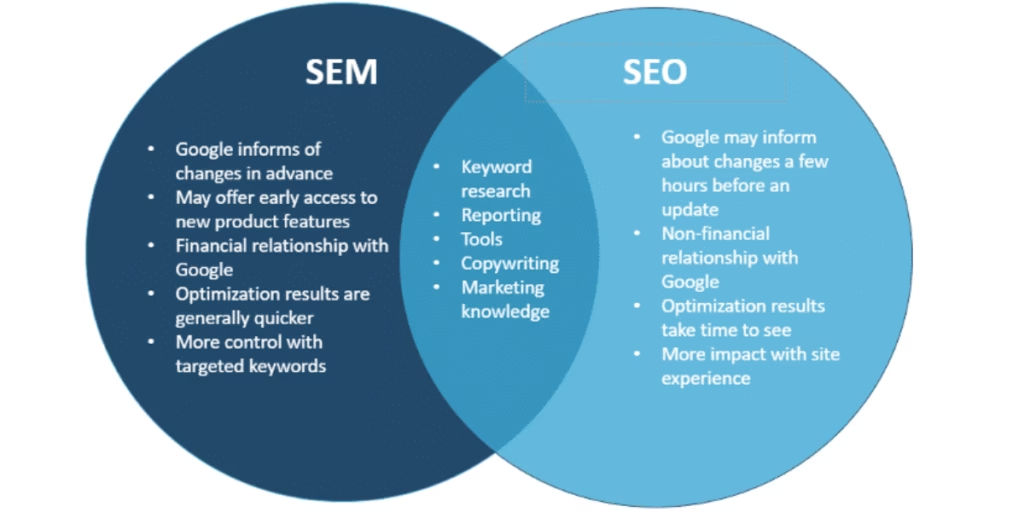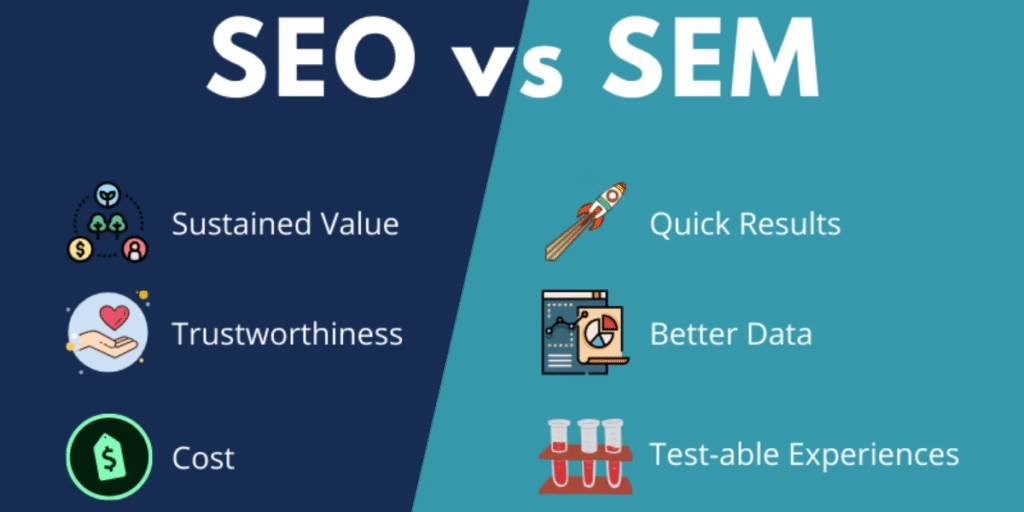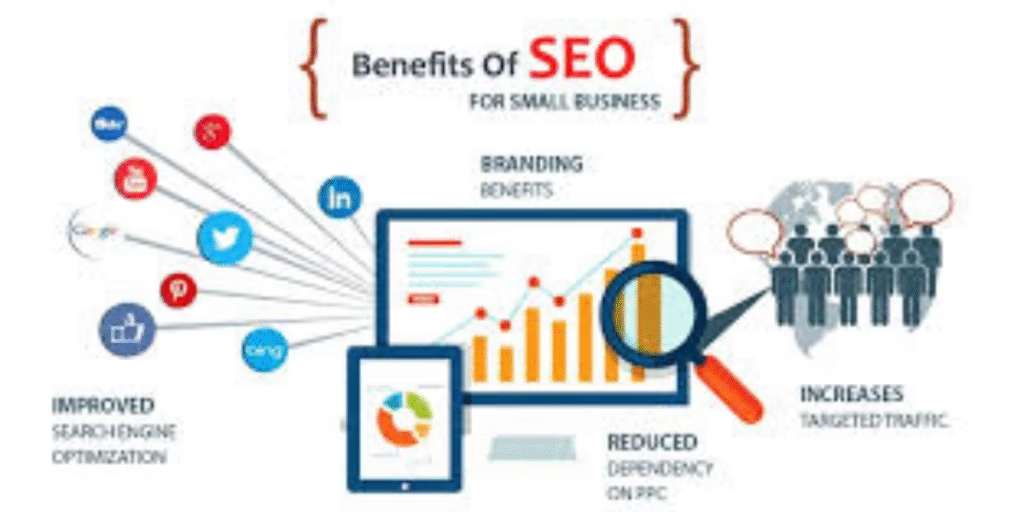SEO is about ranking in search engine results SERPs organically by creating content while SEM is about utilizing PPC campaign and Google Ads to show our websites before organic results within the top search results by paying for advertisement. Both SEO (Search Engine Optimization) and SEM (Search Engine Marketing) are important elements of a successful multimedia marketing campaign and essential to get. Though they have differences in their plans of development, using them collectively will provide the strongest outcomes and broad improvements.

SEO(Search Engine Optimization)
SEO is concentrated on improving a website’s position in organic, unpaid search results. This is accomplished by optimizing unique elements of your website, including written content, site building, and HTML labels, to appear more effectively on search engines like Google without direct payment. Basic components of SEO involve placing out high-quality content, having a reliable website, developing referrals from other sites, and collecting good feedback.
SEM(Search Engine Marketing)
SEM is a paid marketing approach that upgrades a website’s positions in search engines through paid advertising. It’s more commonly designated to as pay-per-click (PPC) advertising, where you technically buy marketing space at the top of Search Engine Results Pages (SERPs).
If you’re looking for SEO and SEM experts for your business/product/services, at Yeilp Inc. You will get experts who will understand your business and target audience needs and write experienced base content that aligns with your business needs and customer expectations.
Why Both are Essential and the Advantages of Utilizing Them Collectively
Improved Awareness and Search Results Page Domination: Combining SEO and SEM will enable your business to dominate both the social media advertisements and the organic search outcomes of a given results page (SERP). This ensures that your website displays more frequently, importantly improving the effectiveness of prospective customers interacting with you on the web. By controlling both organic and paid results, you can build brand recognition and trust among customers.
Rapid Results and Long-Term Profitability: SEM offers rapid advertising and customer growth while you are concentrating on your ongoing SEO campaigns. SEO, while requiring time to develop authority, provides more sustainable visitor growth without regular advertising costs. Utilizing both effectively ensures you see outcomes more quickly than focusing on just one.
Analytical Feedback for Optimization: The insights that you get from your SEM advertisements can improve your SEO techniques. SEM enables you to efficiently test which keywords are most valuable for improving traffic and customer conversions. This statistic can then be applied to optimize your organic content and keyword advertising.
Improved Traffic Quality and Quantity: Adding SEO and SEM will probably increase both the quality and quantity of traffic to your blog or website. SEM can bring in customized traffic that depends on unique keywords and statistics, while SEO can identify customers who are actually interested in your content and offerings. Once on your web page, your message and user-friendly design (often a focus of SEO) can ultimately turn visitors into leads and customers.
Cost Efficiency: SEM involves direct ad expenditure. A comparatively more a credible SEO display can consequently boost your cost per click (CPC) in SEM, as search engines may endorse technically optimized websites with low CPCs. Effective organic search rankings can also enhance your paid ads, allowing for increased reliance on SEM without affecting brand awareness.
Approaching Different Aspects of the Buyer Journey: SEO usually stimulates high-frequency conversions by capturing users searching for details, while SEM can provide long-term sales by identifying users with a particular payment motive.
Competitive Advantage: Businesses that can effectively integrate SEO and SEM are often positioned to overcome competitors who remain focused on only one strategy.

Why is SEO Important?
SEO is valuable for optimizing how efficiently your website communicates with the right audience. Search engine optimization is designed to increase website brand awareness and web traffic acquisition, improve ROI, and make reliable accelerated recognition for your business. Your website visitors are frequently actively searching for updates, products, or solutions that are linked to your business, making them more likely to ultimately convert into customers.
Better ROI
SEO takes time and effort, it can be a less costly way to attract visitors to your website as compared to paid advertising. A reliable website upgrades the results of your marketing advertisements, making your investment advantageous.
Trust and Reliability
Ranking high in search results offers rapid visibility for your business. If search engines like Google recognize you, then people are more susceptible to trusting you.
Search Engine Traffic
Online search is particularly characterized by intent. Visitors are consistently researching updates, products, or solutions that relate to your business, making them ultimately turn into customers. This makes SEO a reliable digital marketing strategy.
Strategic Advantage
In a highly competitive online marketplace, SEO can deliver you with improved online engagement, a recognizable brand, and more authoritative content in your field. This provides stronger targeted traffic to your website, ultimately corresponding to improved brand loyalty and advertising revenue.
Why SEM is important?
Search engine marketing (SEM) is improved the positioning of your brand and article content on search engine results pages (SERPs). Through paid advertisements, your business can rank at the top of search results, ensuring that potential visitors see your products and services. This positive ranking can contribute to broader brand awareness, consideration, and reliability. In the same way, appearing at the top of search results pages can produce stronger recognition and higher probabilities of being visited by targeted visitors.

Increased Target Customers
SEM is a highly efficient way to communicate with your target audience. It enables businesses to target the particular keywords that their upcoming customers are searching for. This indicates you can strategically place your products and services in front of interested customers who are looking to buy at the specific moment they are planning to make a purchase.
Drive Traffic to your Website
SEM will lead significant traffic to your website, landing pages, and product pages. The most important objective of SEM is to optimize a website’s effectiveness, utilizing specialized techniques and programs to deliver more customer traffic.
Higher Click-Through Rates (CTR)
SEM can result in increased click-through rates (CTR) and improved conversions, in contrast to other indirect techniques of marketing. The pay-per-click framework offers businesses the ability to efficiently build customized strategies. This includes clicking on specialized keywords to connect with appropriate customers, and making sure that the advertisements correlate with the visitor’s objectives and desired outcomes.
SEM Operates on a Pay-Per-Click (PPC)
SEM is based on a pay-per-click (PPC) framework, which can be a beneficial strategy. Business owners only pay when their ad is visited, letting them customize accurately how much they consume by identifying a specific cost per click (CPC) and a regular spending limit.
Improve Web Rankings
SEM improved search engine rankings and professional recognition. Boosting traffic to a page through advertisements, ads can technically improve the general traffic to a page and optimize reliability signals when ranked by Google.
Keyword Placement (Applies to Both SEO & SEM)
SEO involving target keywords in page title captions, headings (H1, H2s), meta descriptions, and start paragraphs is highly important for presenting to search engine programs and landing more effectively on the SERP. Search engines process web data and use parameters like keywords to quantify a website’s potential to generate organic traffic. Keyword research is a basic component of SEO, corresponding to the link between businesses and potential customers.

SEM website landing pages have to be linked to the ad descriptions and keywords used in campaigns in order to optimize the Quality Score. A high Quality Score in Google Ads can even equate to low prices on each click. SEM focuses on detailed keyword research as its building block, insuring ads are displayed when potential customers identify identical words or phrases. When a potential customer clicks on an ad, they visit a website, and if the home page is informative and delivers the correct response or solution, the visitor is more likely to engage and convert.
Clear Framework
A properly organized structure (Intro, Problem, Solution, CTA) helps Google evaluate the content for SEO. Search engine developers examine a website’s format to identify its potential to increase organic traffic. A professionally organized website with quick loading speeds is provided with higher rankings.
This structure also retains visitors connected, which increases SEM conversion rates. When a visitor clicks on a web link from a paid ad, a visible structure can drive them directly toward the approach provided and the ideal conclusion. Innovative advertisement pages have a much greater possibility of reaching better conversion rates.
Content Relevance
For SEO, connection enhances ranking. Through sharing out valuable content, businesses convert to search engine strategies and rank more effectively. Search engines monitor website content for professional expertise, authoritativeness and trustworthiness (E-A-T), and it consumes time for useful, high-quality, and freshly written content to get higher in the results pages.
For SEM, improvement in content quality minimizes cost-per-click and optimizes ad ranking. Google determines a Quality Score depending on parameters like the high quality of your website page and the connectivity of your ad to the search topic of interest. Ads with a high Quality Score are often shown more clearly and at a reduced rate. SEM ad campaigns should utilize advantageous keywords for the products or services they provide.
Call to Action (CTA)
SEO content directs visitors to implement action over time by offering insightful information that increases authority and builds engagement, eventually contributing to a conversion. Once visitors are on a website through organic search, content and a thriving website can eventually convert them into clients and then customers.
SEM content appeals for straightaway action the framework, including button positioning and form submission higher than the fold, should proceed to conversion. SEM is focused on sales, and ads are designed based on a unique CTA. A compelling narrative and call to action in a paid ad are essential to generating revenue for as long as you are available to make purchases.
Landing Page Improvement (Especially for SEM)
Straightforward, fast, mobile-friendly pages maximize both visitor interest and ad conversion rates. Search engines provide professionally optimized websites with a higher ranking. For SEM, landing pages that update instantly and are simple to operate help contribute to a positive visitor’s interaction and can optimize Quality Scores, leading to better ad performance.
FAQs
Why is it essential for a business to use both SEO and SEM together?
The most prominent aspect is that your website will appear among both the promotional ads and the genuine search listings on a targeted SERP (Search Engine Results Page). This improved recognition invites more visitors to your website.
Which strategy is more costly, SEO or SEM?
Developing SEO content can be relatively affordable, and probably even without charge if you have the optimum strategy. However, reaching top positions often requires time, effort, and ultimately investing in SEO tools or professional help. SEM offers immediate costs as you pay for ad postings and visitor clicks. Over the short time frame, PPC can sometimes be significantly less costly than the original purchase in SEO. However, with SEM, traffic quits when you stop making payments, whereas SEO can provide ongoing traffic once you perform efficiently.u003cbru003e
How do our both SEO and SEM services improve your online ranking?
Our services have the benefits of using both SEO and SEM for increased visibility. Your website will be displayed in both the digital advertisements and the genuine results on the search engine optimization page, increasing the rate with which visitors and customers connect with your brand.u003cbru003e
Discover more from Yeilp - (Start, Grow, and Scale Your Business)
Subscribe to get the latest posts sent to your email.






